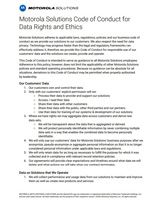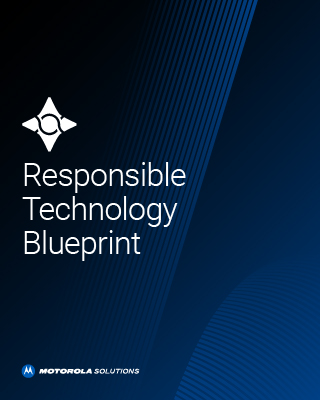


We’re responsible stewards of the technologies we build
Our technology advisory committee and our governance program guide the ethical design, testing & use of our products, so innovations continue to play a positive role in keeping people, property & places safe.

New technologies can progress quickly. MTAC helps to keep our innovations grounded.
The Motorola Solutions Technology Advisory Committee (MTAC) is a cross-functional advisory group within Motorola Solutions that helps to ensure our innovations remain aligned with our purpose and values. As new technologies can advance quicker than legal or regulatory frameworks, MTAC helps to guide the ethical design, development and use of our technologies to be a force for good in society.
MTAC guides our company in three key ways:
Responsible stewardship
MTAC advocates for the responsible design and application of new technologies to protect privacy, secure data and benefit society at large.
Understanding risks
MTAC assesses the potential risks of using new technologies in our solutions and provides a multifaceted perspective on their appropriate use.
Policy guidelines
MTAC develops guidelines and policies surrounding the responsible development, deployment and application of new technologies in our products.
Responsible AI & Technology Stewardship Governance
Our Responsible AI and Technology Stewardship Governance Program helps to implement MTAC’s guidance, working across Motorola Solutions to institutionalize trust in the responsible design, development and use of our products.
Our governance program supports the company in four key ways:
Develops and implements standards
Our governance program creates and institutionalizes standards, processes and guidelines to empower Motorolans to responsibly design and develop our products.
Builds governance and compliance structures
Our governance program builds structures to evaluate our capabilities, identify risks and make recommendations to uphold our responsible innovation principles.
Designs AI educational trainings
Our governance program supports AI literacy through training and education so Motorolans understand their role in responsible AI and technology stewardship.
Compliance with leading AI frameworks
Our governance program bases efforts on standards like the NIST AI Risk Management Framework and is working to align with the AI Management System, ISO42001.
AI Assessments
We continuously evaluate our AI systems to identify and mitigate human-computer interaction and regulatory risks.

Our AI assessment methodology is:
- Underpinned by our responsible innovation principles
- Backstopped by product team testing and validation
- Focused on partnering with stakeholders to safeguard our AI systems and mitigate risk
- Continually maturing, as we routinely reassess our products against evolving AI safety, testing and regulatory standards
AI testing and validation
In tandem with our AI assessments, we test and validate our technologies to verify mitigations and minimize identified risks. Motorola Solutions' product teams meaningfully mature effective processes to test and evaluate in-house, vendor-developed and open source AI systems.
Our AI testing and validation approach starts with the purposeful application(s) of our products, which informs both what must be tested and how it will be tested. We test AI in the context of our users, the specific situations they face, their needs and their evolving workflows. Within this context, we also work to understand how AI performs depending on whether a product’s AI features process audio, video, imagery, text or is multi-modal (i.e., combinations of audio, video, imagery or text). As risks differ for machine learning (ML) or generative AI, testing is further refined per the technology applied as well as where ML and generative AI are used in combination.
To assess each AI feature, we employ a meticulous testing process with specifically designed test sets. Our goal is extensive test coverage, particularly across diverse data distributions and real-world conditions, helping to ensure the AI feature is robust and performs reliably even when faced with unexpected or slightly varied inputs. This comprehensive approach, which includes datasets from industry benchmarks, vendor purchases and Motorola Solutions’ direct collections with proper consent, gives us confidence in the feature's production performance.
We rigorously test edge cases, or less common or unusual situations that could challenge an AI system. By designing tests for scenarios such as extremely low-light conditions for an object detector or heavily accented speech for a voice assistant, we're gaining insights into how the product functions in these important, less frequent real-world situations. This enables us to clearly communicate a feature's limitations to end users so they can use the AI feature appropriately.
When validating results, we assess the efficacy of our AI features by performing internal quality assurance (QA) tests performed by dedicated Motorola Solutions staff, applying red-teaming tests from third party vendors and seeking feedback from early-access industry partners and customers under chaperoned conditions. Results are contrasted against the results of our AI assessments to confirm identified risks are reasonably and effectively mitigated.

